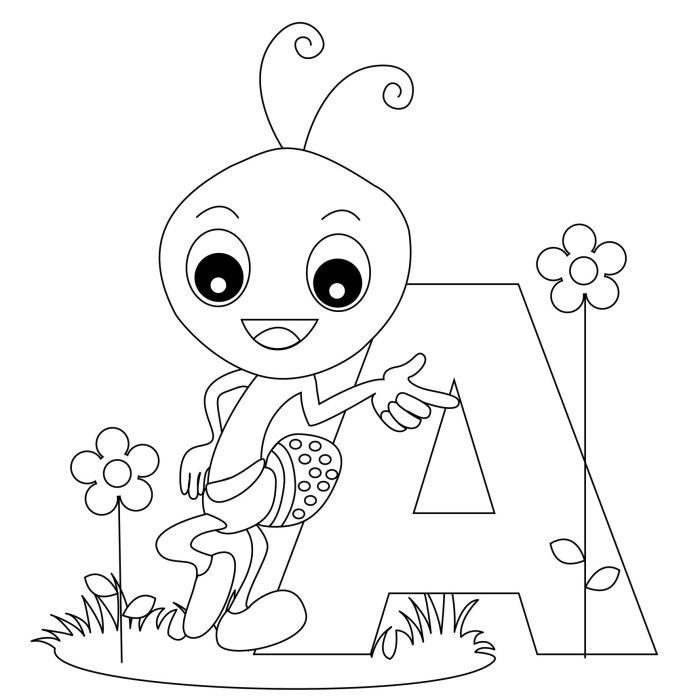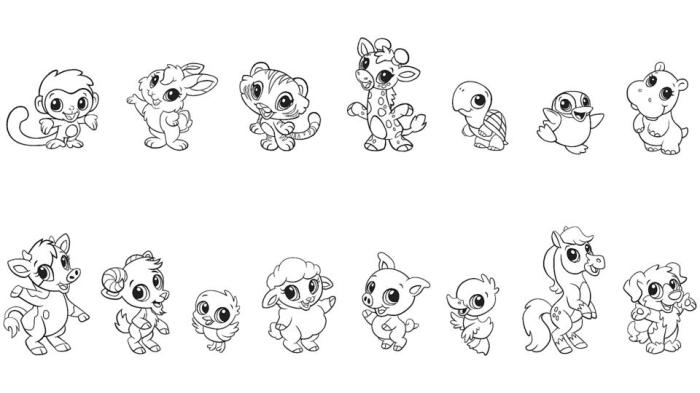Target Audience Analysis

Animal alphabet coloring pages a z – The ideal age range for “animal alphabet coloring pages A-Z” is broadly between the ages of 2 and 6 years old, encompassing preschool and early elementary school children. This range considers the developmental stages where children are actively developing fine motor skills, letter recognition, and an interest in animals.This target audience possesses a strong interest in animals, often exhibiting a fascination with their appearances, sounds, and behaviors.
Their skill levels vary, ranging from rudimentary coloring abilities to more advanced techniques like staying within the lines and adding details. Many children in this age group are beginning to learn the alphabet and associate letters with sounds and words.
Educational Benefits of Animal Alphabet Coloring Pages
These coloring pages offer several significant educational benefits. Firstly, they enhance fine motor skills through the act of coloring itself. The precise movements involved in holding a crayon or colored pencil and controlling its application to the page improve hand-eye coordination and dexterity, crucial for future writing and drawing abilities. Secondly, they aid in letter recognition and alphabet memorization.
Associating each letter with a familiar animal creates a memorable connection, assisting children in learning the alphabet sequence and individual letter forms. Thirdly, they foster creativity and self-expression. Children can choose their own colors, add details, and personalize their coloring pages, developing their imagination and artistic skills. Finally, they can also introduce children to a diverse range of animals, expanding their knowledge of the natural world.
For example, a page featuring a Zebra might spark curiosity about African wildlife, leading to further exploration and learning.
Animal Selection and Arrangement

Creating an engaging animal alphabet coloring book requires careful consideration of the animals chosen and how they are presented. The selection should balance educational value with visual appeal, ensuring the animals are easily recognizable to young children and readily lend themselves to coloring. The arrangement should be logical and intuitive, promoting a positive learning experience.The success of a children’s alphabet book hinges on its ability to both teach and entertain.
A well-chosen selection of animals, coupled with a clear and consistent presentation, will significantly impact the overall effectiveness and enjoyment of the coloring book. A balanced approach ensures the book is both educational and fun.
Common Animal Alphabet List
The following list presents a selection of 26 common and easily recognizable animals, one for each letter of the alphabet, suitable for a children’s coloring book. These animals are widely known and visually distinct, making them ideal for young learners.
- A – Alligator
- B – Bear
- C – Cat
- D – Dog
- E – Elephant
- F – Fox
- G – Giraffe
- H – Horse
- I – Iguana
- J – Jaguar
- K – Kangaroo
- L – Lion
- M – Monkey
- N – Narwhal
- O – Owl
- P – Penguin
- Q – Quetzal
- R – Rabbit
- S – Snake
- T – Tiger
- U – Unicorn (mythological, but widely recognized)
- V – Vulture
- W – Whale
- X – X-ray Tetra (a less common fish, but visually interesting)
- Y – Yak
- Z – Zebra
This alphabetical arrangement provides a simple and logical structure for the coloring book. Children can easily locate their favorite animals and learn the alphabet simultaneously.
Alternative Animal Alphabet List
This list features less common but still visually appealing and relatively easy-to-represent animals. The goal is to offer a more unique and potentially engaging alternative for a subsequent coloring book or a more advanced version. The selection prioritizes animals with distinctive features that translate well into visual representations suitable for coloring.
- A – Aardvark
- B – Baboon
- C – Capybara
- D – Dingo
- E – Echidna
- F – Fennec Fox
- G – Gnu
- H – Hedgehog
- I – Impala
- J – Jackal
- K – Komodo Dragon
- L – Llama
- M – Meerkat
- N – Numbat
- O – Okapi
- P – Pangolin
- Q – Quokka
- R – Rhinoceros
- S – Sloth
- T – Tapir
- U – Urial
- V – Vicuña
- W – Wallaby
- X – Xenopus (African clawed frog)
- Y – Yeti Crab (a visually striking deep-sea crab)
- Z – Zonkey (zebra-donkey hybrid)
The alphabetical order remains consistent, maintaining ease of navigation and promoting alphabet learning. The use of less common animals adds a layer of novelty and discovery, potentially enhancing engagement for older children or those already familiar with a more basic animal alphabet.
Justification for Alphabetical Order
Alphabetical order is chosen for its simplicity and clarity. This arrangement allows for easy navigation and facilitates the learning process. Children can quickly locate animals associated with specific letters, reinforcing alphabet recognition and letter-sound correspondence. This straightforward approach enhances the educational value of the coloring book, making it a user-friendly and effective learning tool.
Coloring Page Design Considerations
Creating engaging and age-appropriate animal alphabet coloring pages requires careful consideration of visual style, color palettes, and design elements to ensure clarity and appeal. The goal is to produce pages that are both fun to color and contribute to learning the alphabet.The visual style and complexity should be tailored to the target age group. Simpler designs with bold Artikels and large, easily colored areas are best suited for younger children (preschool to early elementary), while older children (late elementary and beyond) can handle more intricate designs with smaller details and more complex shapes.
Age-Appropriate Visual Complexity
Younger children benefit from large, simple shapes and bold Artikels. Animals should be depicted in a clear, easily recognizable manner, avoiding excessive detail that might frustrate young colorists. For example, an “A” for alligator could be a simplified shape with large, clearly defined eyes and a wide open mouth. Older children, however, could handle a more detailed alligator with scales, teeth, and potentially a textured background.
The level of detail increases gradually, aligning with the child’s fine motor skill development and cognitive abilities.
Color Palette Selection for Enhanced Visual Appeal and Learning
The choice of color palettes significantly impacts the overall aesthetic and learning experience. Bright, vibrant colors are generally more appealing to young children, stimulating their creativity and engagement. Consider using a limited palette for younger children to avoid overwhelming them with too many choices. For example, a primary color palette (red, yellow, blue) with black Artikels can create a clean, easily colored page.
Older children can benefit from a wider range of colors and more nuanced color combinations to encourage experimentation and creativity. Introducing earth tones, pastels, or even contrasting color schemes can create visually richer and more sophisticated coloring experiences. The use of color can also aid in learning; for example, associating a specific color with a particular animal (like a bright green for a frog) can enhance memorization.
Design Guidelines for Clear Animal Identification and Engagement
Each animal should be clearly identifiable, even within the simplified design. This requires paying close attention to key features that distinguish one animal from another. For example, an elephant needs clearly defined large ears and a trunk, a giraffe needs a long neck and spots, and a zebra needs its characteristic stripes. The animal’s pose and expression can also contribute to engagement.
A playful or curious expression can make the animal more appealing to color. Consider incorporating simple background elements, such as grass, trees, or water, to provide context and add visual interest without overwhelming the main focus—the animal itself. Avoid cluttered backgrounds that could distract from the animal or make it difficult to color. The use of positive and negative space can help emphasize the animal and make it stand out.
Presentation and Distribution

Presenting a complete and engaging set of animal alphabet coloring pages requires careful consideration of both the physical and digital formats. Effective distribution channels are crucial for reaching the target audience and maximizing accessibility. A well-defined marketing strategy will further enhance the visibility and appeal of these coloring pages.
Printable PDF Mock-up
The printable PDF will feature a landscape orientation (8.5 x 11 inches) to maximize space and allow for larger coloring areas. Each page will contain one letter of the alphabet paired with a corresponding animal illustration. The layout will be consistent throughout: the letter will be prominently displayed in a large, bold font at the top of the page, followed by a high-quality, detailed line drawing of the animal.
A small amount of whitespace will surround the illustration to prevent overcrowding. The pages will be organized alphabetically (A-Z) and could include a title page at the beginning with a brief introduction and copyright information. Additionally, a final page could serve as a certificate of completion, offering a fun element for children. The overall design will be clean, child-friendly, and visually appealing, using a consistent color palette to maintain a cohesive look.
The PDF will be optimized for printing, ensuring clear, crisp images and avoiding issues with bleed or misalignment.
Distribution Methods
Several methods can be used to distribute the coloring pages. A dedicated website will serve as a central hub, offering the PDF for download. The website can also include additional content, such as bonus coloring pages, information about the animals featured, and possibly interactive elements. Alternatively, the coloring pages could be offered as a paid or free download through various app stores.
This approach allows for easier access on mobile devices. Finally, a print-on-demand service could be utilized to offer physical copies of the coloring book, expanding the distribution channels and offering a tangible product for consumers who prefer printed materials. This strategy reduces the need for large upfront printing costs and inventory management. Examples of print-on-demand services include Printful and Printify.
Marketing Strategy, Animal alphabet coloring pages a z
To effectively promote the coloring pages, a multi-pronged marketing strategy is recommended. Social media marketing will be key, utilizing platforms like Instagram, Facebook, and Pinterest to share visually appealing samples of the coloring pages and engage with potential customers. Collaborations with parenting blogs, educational websites, and children’s influencers can further expand reach and credibility. Paid advertising on social media and search engines (like Google Ads) can be utilized to target specific demographics interested in children’s activities and educational resources.
Email marketing can be employed to nurture leads and announce new content or promotions. Finally, participating in relevant online and offline events, such as craft fairs or educational expos, can provide opportunities for direct interaction with the target audience and increase brand awareness. Success will be measured by tracking website traffic, download numbers, social media engagement, and sales figures (if applicable).
FAQ Section: Animal Alphabet Coloring Pages A Z
What age range are these coloring pages suitable for?
These coloring pages are designed for children aged 3-8, but can be enjoyed by older children as well, depending on the complexity level selected.
Are the animals depicted realistically?
The animals are depicted in a stylized, child-friendly manner, emphasizing clarity and appeal rather than strict realism.
Can I use these coloring pages for commercial purposes?
Commercial use depends on the licensing agreement associated with the specific coloring pages. Clarification should be sought from the copyright holder.
Where can I find more information about the animals featured?
Additional information on the animals can be found through reputable online resources and children’s encyclopedias.


